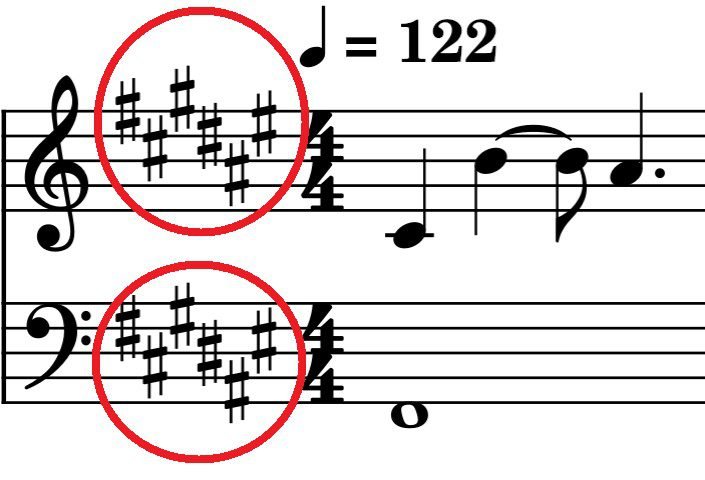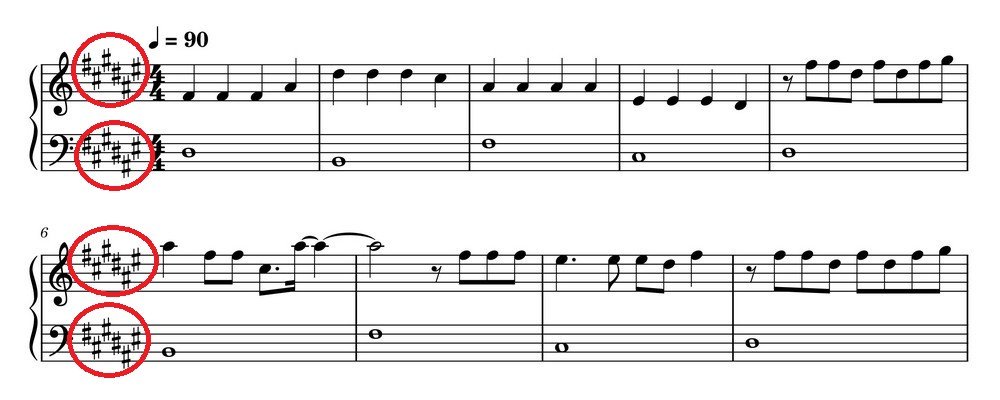Key Signature – First The Basics – What and Why
On this page of “Key Signature: A Beginner’s Guide“, we will first cover the following basic topics on key signatures, such as:
- What is a key signature?
- Where is the key signature located on the sheet music?
- What is the purpose of a key signature?
- What are the different types of key signatures?
- How to write the key signature (Order of Sharps and Flats)?
- How to remember key signatures order with Mnemonic?
- Why are key signatures written in a specific order only?
and the important one:
- What is the relationship between key signature and scale?
- How to identify the scale of a song from its key signature?
What is a key signature?
A key signature is a series of sharps (#) and flats (b) that are placed at the beginning of a piece of music. The beginning of a piece of music means at the beginning of a staff in the sheet music.
As you can see in the image below, the symbols in the red circle are key signatures.

This part in the red circle, with key signature symbols ranging from 1 to 7, tells you which notes are to be played as sharps or flats throughout the song.
The key signature also gives you an idea about the scale used for the song.
The key signature is one of the most important elements of a piece of music, and it is essential for pianists to know the key signature before they start playing. In the next section, we will see why key signatures are so essential.
Where is the key signature located in a piece of music?
The key signature is located on the first line of the staff on the sheet music, to the right of the clef, just before the first measure of music.
You can see in the image below, that key signature symbols are placed immediately after the clef symbol on the sheet music.

In the following example of sheet music for the song Faded by Alan Walker, we can see that the key signatures are written immediately after the clef sign on each staff.

The location of the key signature on the sheet music, immediately after the clef and even before the time signature or any key information, shows its importance in piano music. That means, even before starting to play any key or note on the piano for a song, we should know the key signature for that song.
What is the Purpose of a Key Signature?
As we had mentioned earlier, before you start playing a song, you should know its key signature.
So, why is it important for a pianist to pay attention to the key signature before playing a piece?
The purpose of a key signature is to tell the musician which notes should be played as sharps or flats, without having to write an accidental (sharps and flats) every time one of those notes occurs. With this information, you can also get an idea about the piano scale used for that song.
What happens If We Don’t Write Key Signatures in the Music Sheet?
Without a key signature, we would have to write sharps and flats next to every note that needs to be played sharp or flat in that song.
And then there will be too many sharps and flats and accidentals throughout the sheet music.
While playing a song using such sheet music without any key signature information in the beginning, we will have to pay attention to every note individually to determine whether it is a sharp or flat.
So, the Importance of a Key Signature –
With a key signature, we can simply look at the first measure of music to see which notes are to be played as sharps or flats. So it saves time and effort when reading music and playing songs.
What are the Different Types of Key Signatures?
There are two main types of key signatures: Sharp keys and Flat keys. Sharp keys have sharps in the key signature, while flat keys have flats in the key signature.
In the following image, the key signature on the left side is a Sharp Key Signature, and on the right side Flat Key Signature.

How many sharps and flats can a key signature have?
A key signature can have up to seven sharps or flats, but not both. You will find either sharp symbols in a key signature or flat symbols, but not a mix of sharp and flat symbols in one key signature.
So at the start of the sheet music of a song, you can see either a sharp key signature with only sharp symbols (#) from 1 to 7 or a flat key signature with flat symbols (b) ranging from 1 to 7.
As shown in the below image, the key signature can have either up to seven sharp symbols (upper half of the image) or up to seven flat symbols (lower half of the image).

How to Write Key Signatures
Order of Sharps and Flats
When writing key signature, the order of sharps and flats is always the same, regardless of the key signature.
The order of sharps is:
F#, C#, G#, D#, A#, E# and B#
and the order for the flats is:
Bb, Eb, Ab, Db, Gb, Cb and Fb.
How to Remember Key Signatures Order
Sharp Key Signature Mnemonic
The order of sharps is often remembered with the mnemonic
“Father Charles Goes Down And Ends Battle”
F#, C#, G#, D#, A#, E# and B#
or simply “F-C-G – D-A-E-B,”
which corresponds to the order of sharps in the key signature.
Flat Key Signature Mnemonic
The order of flats is often remembered with the mnemonic (reverse of sharp mnemonic)
“Battle Ends And Down Goes Charles Father”
Bb, Eb, Ab, Db, Gb, Cb and Fb
or simply “B-E-A-D – G-C-F,”
which corresponds to the order of flats in the key signature.
Why sharp and flat key signatures are written in this specific order only, and why not in plain CDE FGAB order or ABCD EFG order.
In the next section, we will see why this order of F#, C#, G#, D#, A#, E# and B# – OR – Bb, Eb, Ab, Db, Gb, Cb and Fb.
To write a key signature, start with a sharp or flat sign on the staff line or space that corresponds to the first sharp or flat in the key. Then, add sharps or flats to the remaining staff lines and spaces in the order listed above.
As we had discussed, sharps and flats are not mixed up while writing key signatures; so, while writing a sharp key signature, simply start with the first sharp F# and add the remaining sharps, no flats, in the order listed above i.e. F#, C#, G#, D#, A#, E# and B#.
So, if you find only one sharp in the key signature area on the sheet music, it has to be F#. If there are two sharps, it will be F# and C#; if there are three sharps, then F#, C#, and G#, and so on.
The image below shows a sharp key signature from one to seven.

The same is applicable for flat signatures. If you find only one flat in the key signature part of the sheet music, it has to be Bb. If there are two flats, it will be Bb and Eb; if there are three flats, then Bb, Eb, Ab, and so on.
This image shows a flat key signature from one to seven.

In the next section of Key Signature: A Beginner’s Guide, we will see why key signatures are written in specific order and how to identify the scale of a song from its key signature. And the important question – How to identify scale of a song from its key signature? and What is the relationship between a key signature and scale?